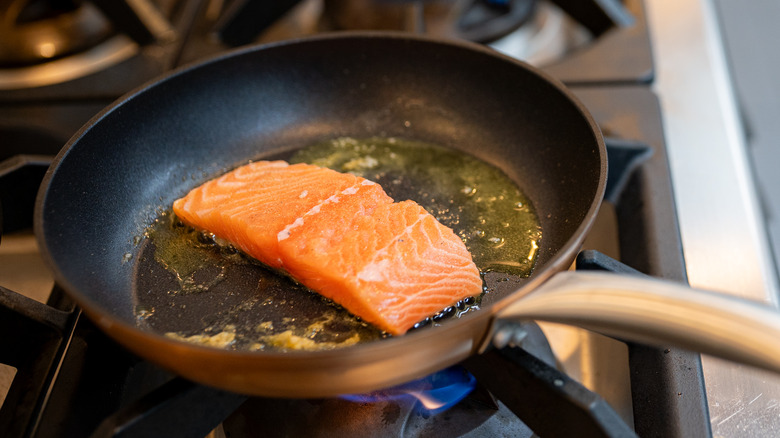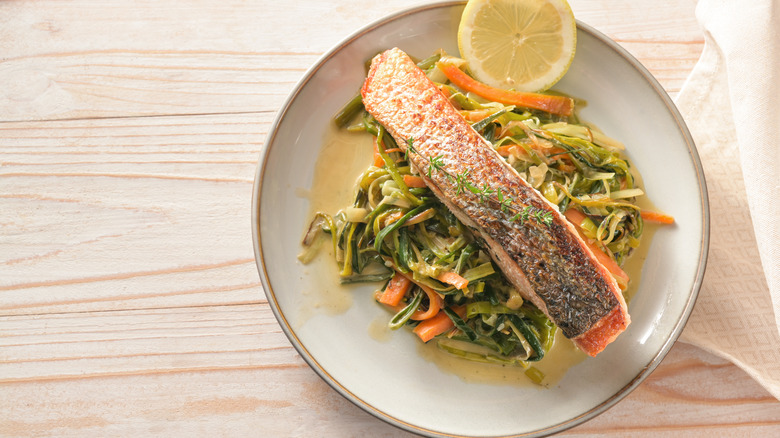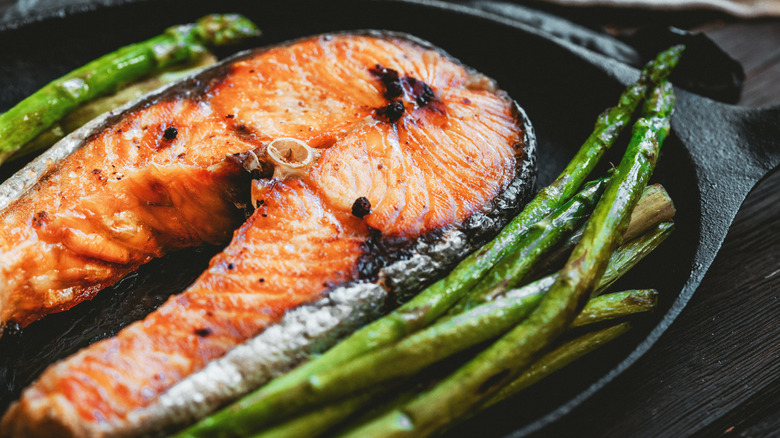Which Side To Cook Salmon On For The Best Flavor
Much like a steak, salmon is perfect for a fancy, filling dinner, and can be enjoyed as well-done, medium, or even rare. No matter which doneness you prefer, the side of the fish you start cooking first will have a profound impact on the final dish. You should always start cooking a salmon filet skin side down — and that skin should be left on, even if you don't plan to eat it.
Salmon skin is packed with omega-3 fatty acids, which can be beneficial for your cardiovascular system, not to mention it's delicious when seared for a crunchy, delectable texture — so much so that some chefs deep-fry it as an alternative to bacon bits. Cooking the fish with the flesh-only side facing up gives the skin more time to crisp up, creating more textural contrast in the final dish.
Cook salmon the other way around, and you'll wind up with dry, overcooked meat and soggy skin. The skin acts as a crucial barrier between the delicate flesh and the high temperatures of your stovetop or oven. The flesh itself will cook more evenly, with less chance of overcooking to a chalky texture. If you like, just peel the skin off once the fish is finished and enjoy the juicy result. However, you can only reap the benefits of cooking salmon this way if you prevent the skin side (and the other side, for that matter) from sticking.
Tips on cooking salmon with the skin side down
Before you begin cooking, pat down all sides of your salmon with a paper towel. Moisture will not only prevent the skin of the fish from crisping up, but will also make it more likely to stick to the pan. Nothing is worse than a filet of salmon that breaks apart, so keep it as dry as possible. You can go a step further by letting your salmon sit for about an hour in the fridge, which will make it restaurant-quality. The dry, frigid air will wick off excess moisture, for the crispest skin with minimal sticking.
Whether you bake, grill, or pan-fry your salmon steaks, you must not get impatient and flip the fish prematurely. The skin should be in direct contact with the skillet — no prodding, scraping, or flipping — for the majority of cooking, or until three-quarters of the flesh has turned a paler pink. Giving the fish time will prevent sticking, in addition to promoting better browning. Once the time is up, flip the fish just once and let it cook to your preferred doneness before plating immediately.
If you're still worried that your filet will stick, especially in the oven, where you can't watch it as closely, place your salmon over some parchment paper to get shatteringly crisp skin. Most parchment can withstand any temperatures under 420 degrees Fahrenheit, making it perfect for high-heat roasting and delivering crisp yet juicy salmon.
Other tips for cooking skin-on salmon
A beautiful filet of salmon not only has crisp skin, but a perfect, intact shape. Salmon benefits from minimal handling during the cooking process. Unlike steak, which has a sturdier texture and arguably cooks more evenly when flipped multiple times, salmon is prone to breaking into flakes if you prod and flip it a bunch. This is because of the smaller, more delicate muscle fibers in fish, compared to those of land animals. A single flip is key for perfect-looking salmon.
Also, there are times when skinless salmon is actually better. While the skin undoubtedly brings delicious flavor and textural contrast, it's rather unappetizing when undercooked. Any "wet" cooking method, such as boiling, stewing, or slow-roasting, will prevent the skin from browning properly. This isn't an issue if you only want the soft, tender flesh of salmon, but if you do want to eat the skin, it will turn out slimy, unless fried separately. Opt for skinless filets if you're going to submerge the fish in a sauce or liquid as it cooks.
Regardless of which cooking method you use for your salmon, remember that the U.S. Department of Agriculture recommends heating up all seafood to at least 145 degrees Fahrenheit. You can cook salmon to rare or medium-rare, if you prefer, but if you're worried about foodborne pathogens, have a meat thermometer at hand and exercise caution.



